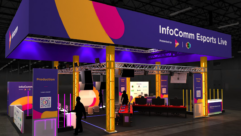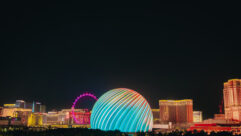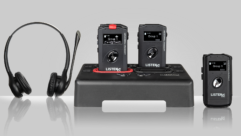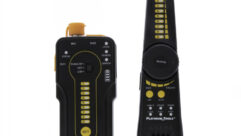INFOCOMM ’98: a review
Jul 1, 1998 12:00 PM,
Peter H. Putman
This year’s INFOCOMM was not characterized so much by new imagingtechnologies as by the implementation and refinement of existing ones.Manufacturers and resellers were content to tread on familiar territorywithout breaking new ground when it came to projectors, monitors andinterfaces. That said, some of the loudest noise came from TexasInstruments and the numerous licensees of TI’s Digital Light Processingtechnology. At last count, more than 15 manufacturers are building orOEMing DMD-engined displays into portable, fixed-mount and stagingprojection systems, not to mention retro monitors and videowall cubes.
The 1,204 x 768 DMDs are now available in quantity, showing up ineverything from light valves (Electrohome’s Roadie, Digital Projection’sPower 3gv/5gv/7gv, NEC’s MultiSync HLO-5000, AmPro’s ALICE 5200) toultraportables (Davis and PLUS). DMDs have also migrated into the videowallarena. In addition to Synelec’s LightMaster, Electrosonic rolled out a 41inch (1.04 m), two-chip DLP cube using 848 x 600 DMDs (and a new controllerfor it called Vector), and Electrohome showed the ED2052-S 52 inch (1.3 m)cube, which also uses a two-chip SVGA DMD engine. Clarity and Imtech arealso building products around DLP technology.
Davis unveiled the DPS-60-TS retro monitor with a new, proprietarytouch-screen interface that lets your finger work like a mouse, andProjectaVision (which recently acquired Vidikron) also displayed itstwo-chip Digital Home Theater 60 inch (1.5 m) retro with removableprojection engine.
LCD displays made their presence known. Chisholm featured the Dakota, a1,280 x 1,024 reflective LCD projection system that looked sharp.Electrohome had previously shown its DLV1280 SXGA projector at NAB ’98 andshowed it again here, as did In Focus with the LP 740. No less than fourcompanies unveiled OEM versions of Hughes-JVC’s D-ILA desktop projector.Dukane, Panasonic, JVC and Proxima will all be selling this 1,365 x 1,024xenon-lamped, boardroom-quality box.
Transmissive LCD products are parked at 1,024 x 768, but they’re gettingsmaller. Epson (PowerLite 5500C) and Sony (VPL-SC50U) showed the firstthree-chip ultraportables with 0.9 inch (23 mm) 800 x 600 polysiliconpanels that will evolve into 1,024 x 768. Epson’s PowerLite series hasbrightness enhancements, as do Sony’s VPL-S600U/X600U desktops. Hitachi(CP-S830), Sharp (NV4) and Sanyo (PLC-SU10N) also broke the 10 pound (4.5kg) barrier with three-chip SVGA projectors. Several companies have XGAversions under development.
At the high end, BARCO continues to refine its 9200 and 8200 lines,fine-tuning its True Color Rendering (TCR) feature to get a more realisticwhite point. BARCO rolled out the BarcoData 3300 SVGA LCD projector andshowed the BarcoReality 812, the only three-gun CRT projector using 12 inch(305 mm) tubes for 1,600 x 1,200 resolution at 300 ANSI lumens. NEC hasmade further lens and software refinements to its MultiSync XG-75 andXG-135 CRT projectors.
There’s still interest in theater-grade projection systems. In addition toBARCO’s 9200, NEC’s MultiSync HLO-3500/5000 and Digital Projection’s Powerseries, AmPro showed the AE-12 light valve, using reflective liquid crystalimaging and Eidophor lamp technology. It’s designed for high-brightnessapplications, as is Hughes-JVC’s ILA-12K, which projected a 15 foot (4.6 m)wide image above the show floor under full room lighting. AmPro also showedits 7000 series LC light valves, and Hughes-JVC brought along the 300 and200 series ILA projectors. Finally, Hughes-JVC showed the Model 200HD, a16:9 ILA designed for HDTV-specific projection.
With plasma displays, the big news was that manufacturers were nowshipping. Fujitsu, NEC, Pioneer and Mitsubishi were well represented atINFOCOMM, with Fujitsu’s 42 inch (1.07 m) 852 x 480 chassis showing upeverywhere from QFTV to Eiki, Clarity and even Sony. Sony’s PFM-500A1WUincorporates the DSC-1204 scan converter for compatibility up to 1,280 x1,024. Pioneer’s PDP-V401 and Mitsu-bishi’s Leonardo are both 640 x 480 40inch (1.02 m) displays; NEC offers Plasma-Sync 33 inch (838 mm) 640 x 480and 42 inch (1.07 m) 16:9 monitor. Panasonic also showed 42 inch (1.07 m)and 50 inch (1.3 m) plasma panels.
The boardroomThe desktop projection crowd has now discovered the installation-gradeprojector marketplace. It was only a matter of time; 1,024 x 768 LCD panelshave been available for several years in amorphous grade and almost a yearin polysilicon. It has become apparent that upgrade and retro projectorinstallations in older buildings are a growing business, seemingly tailoredto the numerous boardroom-grade LCD projectors.
Perhaps the strongest contender in this market is Sanyo’s PLC-9000N XGA LCDprojector, which is also OEM’d by Eiki and Proxima. It showed quite well inthe Projection Shoot-Out against more expensive light valves, but it ispriced competitively with the D-ILA desktops. In Focus also has the LP1000,which is somewhat less expensive, but still true XGA. Pioneer’s RVD-XG10 isapparently around for keeps, and it uses reflective XGA LCD panels.
Mitsubishi’s LVP-X100 has evolved into the X200, thereby doing away withPC-GC remote commands in favor of the more common RS-232 industryhandshake. It features picture-in-picture capability, including a two-upformat ideal for videoconferencing. Sharp has also made improvements inlight output and connectivity to its XG-E3500U, now capable of 1,000 ANSIlumens at 1,204 x 768 resolution.
A sleeper in the installation-grade flat-panel projector market is nView, acompany that’s been quiet with a few financial setbacks. Its introductionof a boardroom-grade XGA projector (P1500) is interesting, but Snell andWilcox’s ownerwhips of a share in nView and its development of video/RGBscaling engines for this projector is even more so, making nView acontender in the installation market.
For whom tolls the bell?Will these and other desktop/installation flat-panel projectors make a dentin the traditional three-gun CRT market? There were very few CRT projectorsin the Shoot-Out this year-only six in the VGA, SVGA and XGA categories. Infact, the only category dominated by three-gun engines was the 1,280 x1,024/1,600 x 1,200 section, featuring four CRT projectors (NEC, Sony,BARCO and Zenith) and one lone LCD engine from ASK. At INFOCOMM ’95, theSuperData (800 x 600) and Graphics (1,024 x 768 and higher) categories wererepresented by 7 inch (178 mm), 8 inch (203 mm) and 9 inch (229 mm)CRTs-not an LCD or DMD projector anywhere. It will be interesting tomeasure that ratio again at INFOCOMM ’01.
The tide will turn when 1,600 x 1,200 flat-panel imaging becomes a reality.At this level, the vertical resolution of everything from SXGA to HDTV canbe accommodated without much compromise. The average person cannot see apixel or line structure much past 1,100 lines at the correct viewingdistance, so manufacturers will concentrate instead on sharpness, contrastand color quality.
InterfacingSuppliers of switching, routing and interfacing products have been just asbusy as display manufacturers. Extron announced a new line of scanconverters, the VSC-100, -200 and -300, with various iterations forgenlocking and broadcast-quality output. Extron also unveiled a six-bandvideo EQ.
The upgrade/retro market hasn’t escaped Extron’s eye either; it haslaunched the System 5cr switcher, an all-in-one RGB/Video switcher with abuilt-in 12 W stereo audio amp and IR interface with learning capabilitiesto follow the projector’s remote control system. This should be a popularproduct for older conference rooms with limited access to wall wiring.
Video scalars are fast becoming the product for sizing video and RGBimages. Folsom Research jumped into this product category with the 2100VFC,a scalar that moves between 640 x 480 to 1,280 x 1,024 (plus NTSC and PAL)with ease. It incorporates two scan converters and a three-channel RGBmixer for seamless cuts and dissolves without breaking sync, a feature alsofound on RGB Spectrum’s SynchroMaster 400. The SynchroMaster 400 alsocombines anything from NTSC/PAL interlaced video to 1,280 x 1,024 andoffers smooth dissolves and cuts between signals.
Faroudja has fine-tuned its VP600 Presentation Plus scalar, first seen atNAB ’97. It scales video signals up to the sweet spot of an LCD, DLP or CRTprojector (maximum resolution 1,024 x 768) and allows the mixing of RGBcomputer signals. Video can be overlaid on Windows screens or adjustedanamorphically. Finally, Communications Specialities was also active inscaling, showing Deuce, an inexpensive scalar with six preset outputresolutions to 1,280 x 1,024, including the 852 x 480 plasma pixel count.










